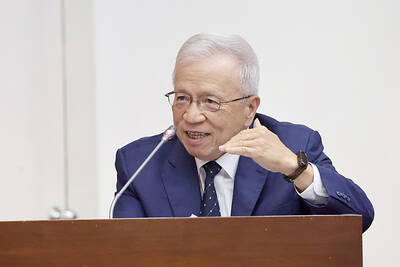The voters of Monroe County, Michigan, might have expected an economic windfall when they flipped from supporting Democrat then-US president Barack Obama to help put US President Donald Trump in the White House in 2016.
However, it went the other way: Through the first three years of the Trump administration, the county lost jobs and brought in slightly less in wages in the first three months of this year than in the first three months of 2017 as Trump was taking over.
That was before the COVID-19 pandemic and the associated recession.

Photo: EPA-EFE
With the US election just days away, recently released government data and new analysis show just how little progress Trump made in changing the trajectory of the Rust Belt region that propelled his improbable rise to the White House.
While job and wage growth continued nationally under Trump, extending trends that took root under Obama, the country’s economic weight also continued shifting south and west, according to data from the US Quarterly Census of Employment and Wages (QCEW) that was recently updated to include the first three months of this year.
A study from the Economic Innovation Group (EIG) pointed to the same conclusion. It found relative stagnation in economic and social conditions in the Midwest compared with states like Texas or Tennessee where “superstar” cities, such as Dallas and Nashville, enjoyed more of the spoils of a decade-long US expansion.
Across the industrial belt from Wisconsin to Pennsylvania, private job growth from the first three months of 2017 through the first three months of this year lagged the rest of the US — with employment in Michigan, Wisconsin and Ohio growing 2 percent or less over that period compared with a 4.5 percent national average, according to QCEW data.
By contrast, Texas and California saw job growth of more than 6 percent from 2017 through the start of this year, while Idaho led the nation with employment growing more than 10 percent.
Perhaps notably for the election, an analysis of 17 prominent counties in the five battleground states of Florida, Michigan, Ohio, Pennsylvania and Wisconsin showed the limits of Trump’s controversial tax and trade policies in generating jobs where he promised them. All 17 of the counties had a voting-age population greater than 100,000 people as of 2016, supported Obama in the 2012 election and voted for Trump in 2016.
In 13 of those counties, all in the Rust Belt region, private job growth lagged the rest of the country. Employment actually shrank in five of them. Of the four with faster job growth than the rest of the country, two were in Florida, one was in Pennsylvania and one was in Wisconsin.
The findings show that under the “greatest economy ever” boasts that Trump made before the pandemic, when job and wage growth were indeed strong, the fundamental contours of regional US prosperity seemed largely unchanged.
Some of that might have stemmed from Trump’s own policies. The use of steel tariffs, for example, might have ended up costing Michigan jobs.
“The key battleground areas ... have not fared well under President Trump, even prior to the pandemic,” Moody’s Analytics chief economist Mark Zandi said.
The swing state counties most supportive of Trump in 2016 were “especially vulnerable” to the president’s trade war tactics because of their ties to global markets, he said.
However, Trump was also swimming against a very strong tide, driven by forces bigger than a tweet or a tariff can likely counter.
For decades, people, capital and economic output have been shifting from a mid-20th century concentration in the US northeast and Midwest to the open land, cheaper wages and more temperate climate of the Sun Belt, and the innovation corridor from Silicon Valley to Washington state.
Trump, in his 2016 campaign, put a premium on manufacturing jobs — last century’s path to the middle class — and as president used a combination of trade policy, tariffs and blunt force arm-twisting on companies to try to shore up the prospects of the industrial heartland that formed his electoral base.
It did not happen. Texas, according to QCEW data, gained more manufacturing jobs from 2017 to the start of this year than Ohio, Michigan, Wisconsin and Pennsylvania combined; the smaller, but increasingly competitive manufacturing cluster in Tennessee, Georgia, South Carolina and Alabama gained as many factory positions as those legacy manufacturing states.
While Trump might have failed in his efforts to reinvigorate the Rust Belt, the forces acting against the region predate his administration.
A longer-term analysis by the EIG, looking at outcomes across an index of social and economic measures, showed little progress from the start of the century through 2018.
According to an analysis of EIG data, two to three times as many counties in Ohio, Pennsylvania and Wisconsin slipped further down the think tank’s Distressed Communities Index as climbed to a more prosperous bracket over those nearly two decades.
In Florida and Washington state, by contrast, five times as many counties moved into a more well-off bracket, and in California three times as many counties prospered.
EIG research director Kenan Fikri said it was “easy to forget” that the Midwest and Great Lakes regions were once the “pinnacle of what the US had to offer” before the economy shifted to a more technology, service-oriented and global footing.
“We have seen the gravity of economic well-being take a dramatic shift to the west... It continued unabated through the first several years of the Trump administration,” he said.

JITTERS: Nexperia has a 20 percent market share for chips powering simpler features such as window controls, and changing supply chains could take years European carmakers are looking into ways to scratch components made with parts from China, spooked by deepening geopolitical spats playing out through chipmaker Nexperia BV and Beijing’s export controls on rare earths. To protect operations from trade ructions, several automakers are pushing major suppliers to find permanent alternatives to Chinese semiconductors, people familiar with the matter said. The industry is considering broader changes to its supply chain to adapt to shifting geopolitics, Europe’s main suppliers lobby CLEPA head Matthias Zink said. “We had some indications already — questions like: ‘How can you supply me without this dependency on China?’” Zink, who also

At least US$50 million for the freedom of an Emirati sheikh: That is the king’s ransom paid two weeks ago to militants linked to al-Qaeda who are pushing to topple the Malian government and impose Islamic law. Alongside a crippling fuel blockade, the Group for the Support of Islam and Muslims (JNIM) has made kidnapping wealthy foreigners for a ransom a pillar of its strategy of “economic jihad.” Its goal: Oust the junta, which has struggled to contain Mali’s decade-long insurgency since taking power following back-to-back coups in 2020 and 2021, by scaring away investors and paralyzing the west African country’s economy.

BUST FEARS: While a KMT legislator asked if an AI bubble could affect Taiwan, the DGBAS minister said the sector appears on track to continue growing The local property market has cooled down moderately following a series of credit control measures designed to contain speculation, the central bank said yesterday, while remaining tight-lipped about potential rule relaxations. Lawmakers in a meeting of the legislature’s Finance Committee voiced concerns to central bank officials that the credit control measures have adversely affected the government’s tax income and small and medium-sized property developers, with limited positive effects. Housing prices have been climbing since 2016, even when the central bank imposed its first set of control measures in 2020, Chinese Nationalist Party (KMT) Legislator Lo Ting-wei (羅廷瑋) said. “Since the second half of

AI BOOST: Next year, the cloud and networking product business is expected to remain a key revenue pillar for the company, Hon Hai chairman Young Liu said Manufacturing giant Hon Hai Precision Industry Co (鴻海精密) yesterday posted its best third-quarter profit in the company’s history, backed by strong demand for artificial intelligence (AI) servers. Net profit expanded 17 percent annually to NT$57.67 billion (US$1.86 billion) from NT$44.36 billion, the company said. On a quarterly basis, net profit soared 30 percent from NT$44.36 billion, it said. Hon Hai, which is Apple Inc’s primary iPhone assembler and makes servers powered by Nvidia Corp’s AI accelerators, said earnings per share expanded to NT$4.15 from NT$3.55 a year earlier and NT$3.19 in the second quarter. Gross margin improved to 6.35 percent,